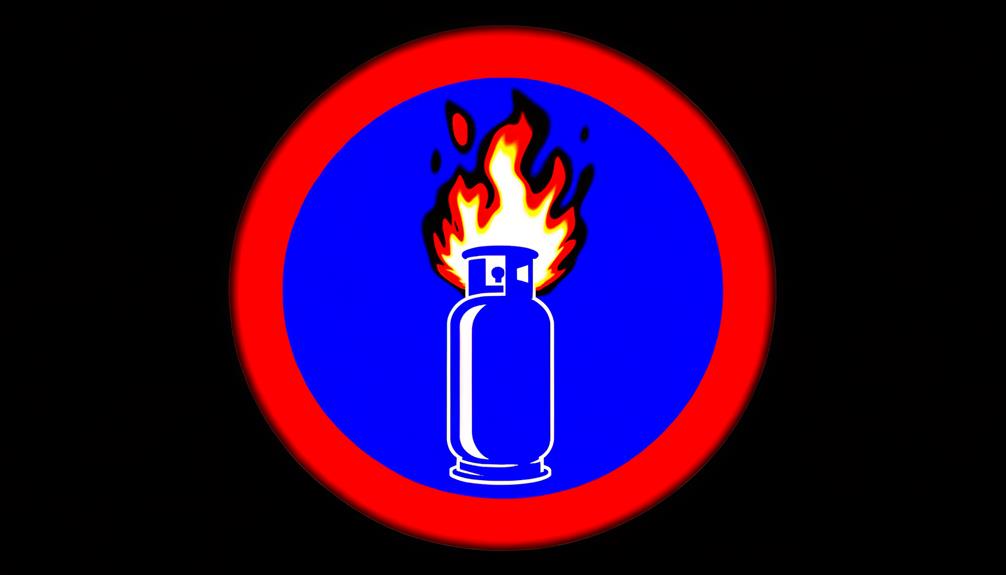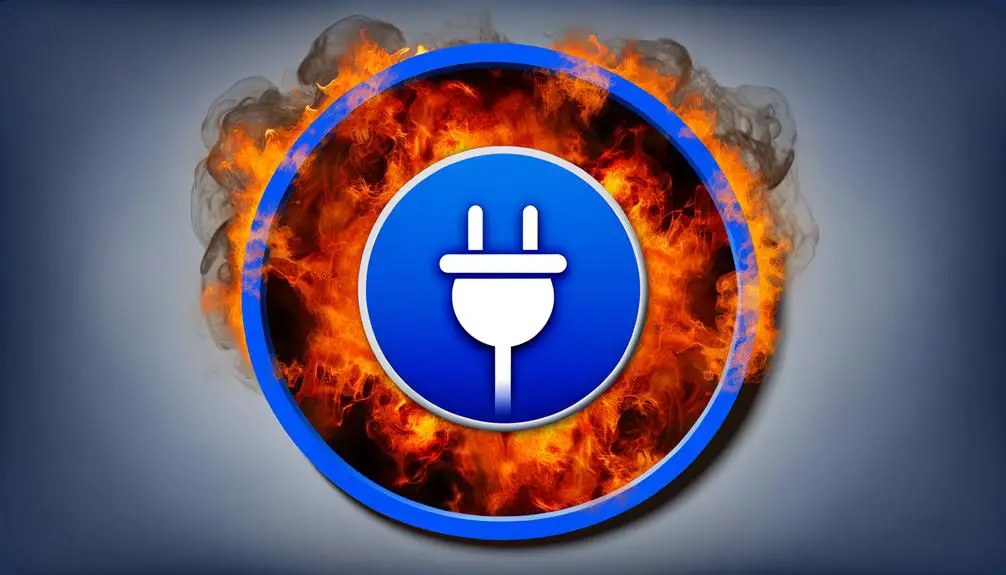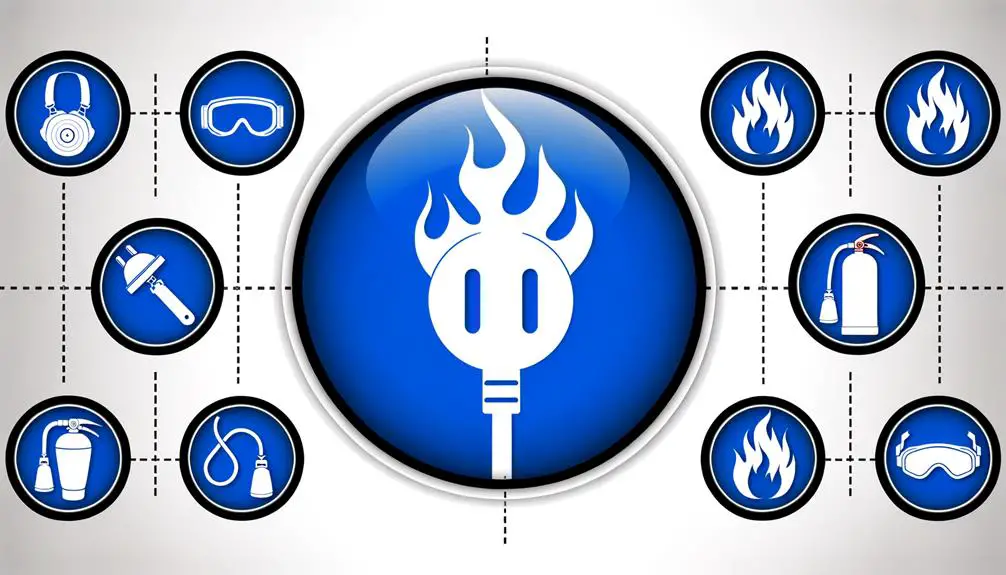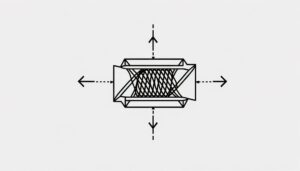Symbol for Class C Fire
The symbol for a Class C fire is a blue circle containing a white 'C.' This symbol specifies fires involving energized electrical equipment, which require non-conductive extinguishing agents. The blue color underscores the crucial need to avoid water-based extinguishers to prevent electrocution.
Recognizing this symbol guarantees the appropriate response to electrical fire emergencies, enhancing safety for both professionals and the general public. Incorporating this symbol into safety protocols is essential for effective fire prevention and control measures.
Guaranteeing proper identification and response to Class C fires hinges on understanding this crucial symbol. Discover further insights into fire safety practices.

Key Takeaways
- The Class C fire symbol features a blue circle with a white 'C'.
- It indicates fires involving energized electrical equipment.
- The blue color signifies the need for non-conductive extinguishing agents.
- The symbol helps in selecting appropriate extinguishers to avoid electrocution.
- Clear and simple design ensures immediate recognition during emergencies.
What Is a Class C Fire?

A Class C fire is defined as a fire that involves energized electrical equipment. These fires typically occur in environments where electrical wiring, circuit breakers, outlets, or appliances are present and actively powered.
The presence of electricity adds a unique hazard, necessitating specialized extinguishing agents that do not conduct electricity. Common extinguishing agents for Class C fires include dry chemical extinguishers and carbon dioxide. It is vital to avoid water-based extinguishers, as water conducts electricity and poses a risk of electrocution.
When dealing with Class C fires, it is essential to de-energize the equipment if safe to do so. Proper understanding and handling of Class C fires are crucial for ensuring safety and preventing further electrical hazards.
Recognizing the Symbol
Recognizing the symbol for a Class C fire is crucial for guaranteeing the accurate response to electrical fire emergencies. The symbol typically features a blue circle with a white capital letter 'C' in the center. Proper identification of this symbol is indispensable for both fire safety professionals and the general public. Below is a table summarizing key aspects of the Class C fire symbol:
| Aspect | Details |
|---|---|
| Shape | Circle |
| Color | Blue |
| Letter | White 'C' |
| Usage | Electrical fires |
| Importance | Correct extinguisher selection |
This standardized symbol helps secure that the correct type of fire extinguisher is used, thereby minimizing the risk of electrical shock and effectively extinguishing the fire.
Design Elements

The design elements of the Class C fire symbol are critical for effective communication and hazard identification. Key aspects include the color scheme's significance in conveying the urgency and nature of the electrical fire risk, as well as the icon's shape and clarity to guarantee immediate recognition and understanding.
These elements work in unison to enhance safety protocols and response efficiency.
Color Scheme Significance
Color schemes in fire safety symbols are meticulously designed to convey vital information quickly and effectively.
For Class C fire symbols, which denote electrical fires, colors play an essential role in ensuring immediate recognition and appropriate response. Typically, the symbol incorporates a blue background, signifying the need for specialized extinguishing agents that do not conduct electricity. This contrasts sharply with other fire classes, aiding in rapid identification.
Moreover, the use of white or black iconography within the blue field enhances visibility and legibility under various lighting conditions. This deliberate color scheme not only differentiates Class C fires from other types but also reinforces the importance of using non-conductive extinguishing methods, thereby preventing electrical hazards during firefighting operations.
Icon Shape and Clarity
Ensuring icon shape and clarity in Class C fire symbols is vital for effective communication and prompt action. The design elements must be precise to avoid any ambiguity, facilitating quick recognition during emergencies.
Key considerations include:
- Simplicity: The icon should be straightforward without unnecessary details, guaranteeing instant recognition.
- Contrast: High contrast between the symbol and background improves visibility under various conditions.
- Universal Design: Adhering to widely accepted design standards guarantees the symbol is recognizable globally.
- Proportions: Maintaining balanced proportions guarantees the icon remains clear and legible at different sizes.
These principles are essential in creating a Class C fire symbol that is both effective and easily understood, ultimately enhancing safety and response efficiency.
Importance of the Symbol
Recognizing the symbol for a Class C fire is vital for guaranteeing proper response and safety measures in environments where electrical equipment is present. This symbol, typically denoted by a blue circle with a white 'C' or an image of an electrical plug, instantly communicates the specific nature of the fire hazard.
Accurate identification enables personnel to select appropriate extinguishing agents, such as non-conductive chemicals, thereby preventing electrical shock and additional damage. Misidentification could lead to the use of water-based extinguishers, exacerbating the risk.
Moreover, the symbol aids in rapid decision-making during emergencies, minimizing response time and enhancing overall safety. Standardized symbols ensure consistent understanding across diverse teams, essential for maintaining a safe operational environment.
Safety Protocols

Implementing thorough safety protocols is essential to effectively manage Class C fire hazards in environments with electrical equipment. Ensuring the safety of personnel and property requires a strategic approach that encompasses several key measures.
First, it is necessary to regularly inspect and maintain all electrical systems to prevent potential ignition sources. Additionally, having appropriate fire suppression systems specifically designed for electrical fires is important.
Key safety protocols include:
- Ensuring proper labeling of electrical equipment to identify potential fire hazards.
- Implementing strict lockout/tagout procedures to prevent accidental energization.
- Using non-conductive tools and equipment when working near live circuits.
- Regularly auditing and updating safety policies to align with the latest standards and regulations.
These protocols are essential for mitigating the risks associated with Class C fires.
Training and Awareness
Thorough training and awareness programs are crucial for equipping personnel with the knowledge and skills necessary to prevent and respond to Class C fire incidents effectively.
Detailed training should cover the identification of electrical fire hazards, proper use of fire extinguishers rated for Class C fires, and safe evacuation procedures. Regular drills and simulations make certain that staff remain proficient in emergency protocols.
Additionally, awareness initiatives, including instructional materials and signage, reinforce the importance of vigilance and adherence to safety standards. Highlighting the unique characteristics of Class C fires, such as the risks posed by energized electrical equipment, is essential.
Ultimately, well-informed personnel greatly contribute to minimizing the occurrence and impact of Class C fire events.
Conclusion
Coinciding with the need for safety and efficiency, the Class C fire symbol serves a critical role in hazard identification. Its design elements, standardized for clarity, guarantee immediate recognition and appropriate response.
The importance of this symbol cannot be overstated, as it directly influences safety protocols and emergency preparedness. Thorough training and awareness of the symbol's significance further enhance safety measures, culminating in a well-coordinated approach to electrical fire incidents.






